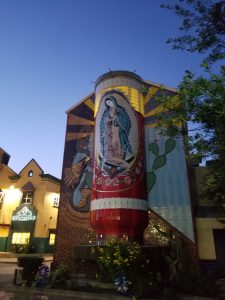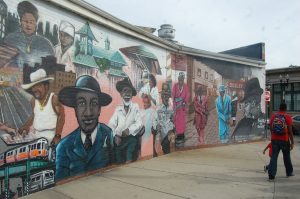Shelf Life Community Story Project, https://www.shelflifestories.com/. Created by Mayowa Aina, Jill Freidberg, Domonique Meeks, Inye Wokoma, Carina del Rosario, Henry Luke. Reviewed on March 4th, 2019 by Gabriel Cohen.
Introduction
The Shelf Life Community Story Project is a community driven website developed at the grassroots level to share the stories of Seattle’s Central District community. The Central District, commonly referred to as the ‘CD’ was undergoing a transformation as one of the core elements of the community, the local Red Apple grocery store was being shut down. At face value this may seem a common and natural development as neighborhoods change and grow throughout the years. However, the loss of the Red Apple had massive implications for the CD community. The store was a central location of the CD community – a place where people would work and shop, but also meet and socialize. The loss of this forum dealt a harsh blow to the community’s morale, and became a part of the ongoing process of gentrification that disrupts and displaces communities. Shelf Life is part of a community effort to ensure that the stories and experiences of this community don’t expire along with the Red Apple. The loss of the Red Apple, deemed so important to the character of the CD community means that the community itself is different.
Presentation
The website is easy to navigate, and is simple and aesthetically pleasing. The presence of a simple, clean interface and a layout emphasizing photography is undoubtedly inviting to visitors. There is minimal navigation necessary – the organization of the website requires only one to two different clicks or keystrokes to engage in its content, which is something that other public history projects should take note of and incorporate into their own sites. Aside from these photos there is simply a well designed cover photo and what appears to be their mission statement, “Amplifying community voices, learning from neighborhood stories, and interrupting narratives of erasure in Seattle’s Central District.” Their website reflects their mission through its simple and appealing design, but also provides the opportunity to learn more for those who are interested.
Audience
The website uses the voices of the community rather than their own to tell their story. Undoubtedly, this would be very appealing to the CD community and to other communities interested in finding a way to tell their story. Pages dedicated to sharing news of events and developments in the project also serve as an ongoing history of shelf life, and a resource for would-be community organizers that are looking for a place to begin on their own projects.
Content
The main content of Shelf Life are its oral histories accompanied by fantastic photography. The content is divided into specific pages that share the story of an individual from the community. These story pages require you to access each individually, but that is a great source of the site’s appeal. By hovering over a story page, visitors will see a caption that is just intriguing enough and just vague enough to encourage them to delve deeper and read that particular story. Once accessed, the story page consists of a photograph and a brief oral history of the individual’s relationship to the CD community. The voice of the interviewer is completely absent – all focus is on the individual being interviewed and their story. In this way, the organization of content of Shelf Life compliments the goal of the project designers: to give a voice to a community undergoing great change and in danger of irreversible and unwanted transformation.
Developers
The group that brought Shelf Life to us is a very diverse group. Their commonality is that they call the CD, Seattle or at Washington state home. The diversity of the Shelf Life development team is undoubtedly of great benefit. The team possesses individuals with different strengths, ranging from researching to storytelling to photography and even data analytics. More importantly, Shelf Life benefits from the input of people of vastly different life experiences. For a project that is all about finding an outlet for the voices of the CD community and incorporating historical context and visual storytelling methods in the process, this diversity of talent and experiences is critical.
Conclusion
Shelf Life isn’t overly ambitious. It seeks to do a very specific task and do it well: share the personal experiences of the CD community. The value of Shelf Life is in this simplicity. In the process of engaging in community driven storytelling, they accomplish their goals of granting longevity and relevance to communities undergoing change in the face of urban gentrification. Moreover, the experiences of the CD as it undergoes this transformation can serve as valuable historical information for communities that undergo similar experiences in the future. The type of personalized, visual storytelling Shelf Life shares is of great benefit to local communities, public and local historians and even as a memoir of communities fundamentally altered or lost to ubran development.


